
|
 |

|
 |
My dance and culture trip to Tamil Nadu - Tara Panicker November 10, 2015 This year I had a very special start to my summer holidays. From the 20th to the 25th of July, I travelled with my dance teacher, Usha Raghavan, and six of her students (along with their guardians) on a temple tour around Tamil Nadu. We visited four temples: first, the beautiful Thillai Nataraja temple at Chidambaram, then the quietly resplendent Gangaikondacholapuram temple, the impressively grand Brihadeeswara temple at Tanjavur, and most significantly, the seat of dance, Thyagaraja Temple at Thiruvarur. Teacher has organised trips like this before: taking her students from UK and Italy on a tour of temples which are associated with Bharatanatyam and sometimes even other dance forms. This trip, however, was different, in that the first week would be spent in Tamil Nadu, and the second would be touring dance performances in Sri Lanka. The India tour hence was incredibly busy, but also incredibly enriching. Though this was a tour of some of the most significant temples in Tamil Nadu's history, it was not restricted to just that. We also visited some fantastic sites which offered us a wider understanding of the history and culture of Tamil Nadu and South India: the Dakshinachitra model heritage village in Mahabalipuram, a village in Tanjavur where the famed Tanjore sculptures and paintings are made, and even a veena-making shop. Dakshinachitra was both educational and enjoyable. It had been constructed in the fashion of an old-style village to offer an insight into the customs and behaviour of South Indians, and featured aspects of the four Southern states (Tamil Nadu, Kerala, Karnataka, Andhra Pradesh). For example, we saw a traditional village home from Tamil Nadu, and were given an opportunity to try our hands at various activities, such as pottery making, basket weaving, and grinding flour, all demonstrated by artisans from villages which used the same (or similar) techniques passed down over the generations. Mahabalipuram was my favourite of these three stops, followed closely by Dakshinachitra. It consists of a group of monuments built by the Pallava rulers around the 7th and 8th centuries. These monuments are unique - they consist of the five Pandava Rathas, the Panchapandava cave temple, several other mandapas, and the most famous rock-relief, describing Ganga's descent onto the earth, also known as Arjuna's or Bhagiratha's Penance. I found the experience of seeing these monuments amazing - the Mahabharata has long been a much-loved text for me, and I had never even imagined that shrines had been built for its heroes. However, they were left incomplete, and so these shrines are not worshipped at, but they still offer an awe-inspiring and beautiful sight to admire. I also appreciated the design of each Ratha, as each was built in line with its namesake's characteristics. The most impressive detail about all of these shrines is that they are all monolithic structures, each carved from a single rock. The size of the temples suggests that the rocks used for the temples sloped from south to north, in keeping with the laws of vastu-shastra - or as we know it, architecture.  Chidambaram temple 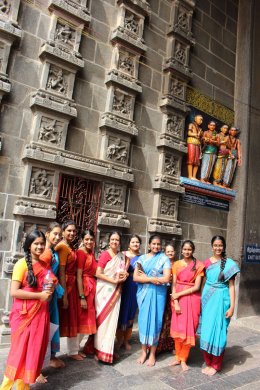 Temple entrance with karanas We reached Chidambaram in the late afternoon. The most prominent Shiva temple in India is guarded at each corner by a colourful gopuram, with images of devis and devas and many other deities painted with pinks, reds, yellows and blues - almost every colour imaginable was featured on those gopurams. Each gopuram is oriented towards one of the four cardinal directions, all exactly the same size and shape. There was a huge crowd teeming around the temple, waiting for the evening puja performed for the spatika linga. We were then ushered outside to observe the palanquin ceremony. This consisted of the deity in the form of Palaiarai Nataraja being placed on a palanquin and taken to his beloved consort Parvati, who waits in their bedchamber every evening. The occasion is celebrated with great pomp and splendour with music from every conceivable instrument, such as the melam, maddalam, nadhaswaram, jalra bells, and the conch, serenading the god. The deity was also fanned and shaded by an umbrella, and women devotees drew kolams before the procession. The crowd followed the palanquin, singing songs and clapping their hands in time to the music - it was truly an impressive ceremony to observe and take part in. Once the evening ceremonies were concluded, we sat on the steps before the Nataraja shrine and appreciated the atmosphere - the worshipping of the devotees, the flickering of the deepams, and their reflections on the painted images and shrines - a meditative, soothing experience. The next morning we woke up bright and early, and after breakfast, Teacher showed us how to wear our dance saris for the first time. It was especially interesting for me as I've had a great deal of difficulty attempting to wear normal saris before! Luckily these dance saris are shorter to drape than traditional saris, and Teacher's demonstration and helpful tips made it all seem very simple. We reached the temple later than anticipated, arriving at 8:30 instead of 8am. As a result, instead of our friend the honourable Dikshitar showing us around the temple after we had danced, we would have to return in the evening for our tour. We would soon find out the reason for this! After watching the morning puja, we were led towards the huge dhwajastambam and invited to dance. All of us students performed several dances, beginning with Anjali Stotram and finishing with Kavuthuvam. After that, Teacher wanted to at least show us the water tank, even if we could not see the rest of the temple in the morning. However, the flag stones of the temple had been heating all morning underneath the fiery summer sun, and we barely made it halfway across the blazing uncovered stones before we had to turn back - and run for shelter before our feet burned off! We had to admit defeat for the morning, and so we made our way back to the hotel -the midday heat was so overpowering that several of us had to unwind part of our dance saris and use them as make-shift parasols! After lunch and some rest, Teacher had a surprise for us - we were going on a boat trip on Pichavaram Lake! It was very enjoyable; the air was cool and calm, while the lake itself was gentle. Of special interest to me were the mangrove forests populating the river banks. In the evening, we returned to Chidambaram temple and finally received our tour from the dikshitar who also told us about the significance of the four gopurams, and how they faced each of the four cardinal points. He pointed out the karanas on the gopurams, narrated their history, and showed us the sculptures of the dancers and musicians on the temple colonnades. The dikshitar told us all about the various myths and legends associated with the temple - such as how apparently Lord Shiva had manifested there and performed the Ananda Tandava, at the prayers of a fervent devotee, and for that reason a shrine devoted to Shiva dancing the Tandava had been set up there. Teacher then led a workshop about the temple: what we had seen the day before during the evening puja, the ceremony of taking Palaiarai Nataraja to Parvati, and then our experiences of the day, such as dancing before the dwajastambam and our tour of the temple. She showed us how to depict all these actions through dance, and under her guidance we created a short natya sequence telling the story of what we had seen and learned at Chidambaram temple. 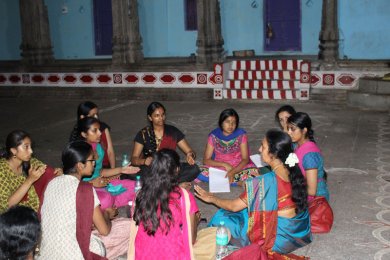 Workshop inside Chidambaram temple 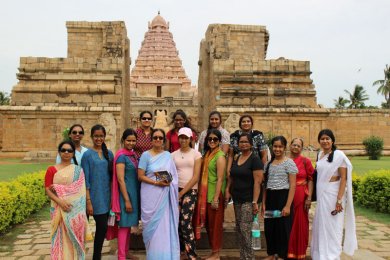 Gangaikondacholapuram temple The next morning, we left Chidambaram for Tanjavur, stopping halfway to visit Gangaikondacholapuram, which was easily my favourite of all the places we visited. It is a complex comprising the main temple dedicated to Shiva, surrounded by several other shrines, a well, and a colossal couchant Nandi in front. The temple was built by Rajendra Chola I, son of Raja Raja Chola I, who built Tanjavur Brihadeeswara Temple. The first view of Gangaikondacholapuram is awe-inspiring. Walking up the pathway to the entrance, the visitors are greeted by two towering dwarapalakas standing on either side of an even taller doorway, and immediately ahead, a colossal Nandi can be seen lying in front of a soaring gopuram. Upon reaching the temple the visitors step into the maha-mandapa from a side staircase. The temple itself is silent, with no loud bells or noise echoing around its walls. The pathway to the inner sanctum is 200m from the entrance, and no lights apart from glimmering flames from the deepams on the columns lining the corridor shine. The dusky light within the temple and the soft silence offers a sense of reverence and wonder, and the visitors find themselves almost overwhelmed by the quiet sanctity. The long walk down the pathway only intensifies this sense, and with each step the visitors are faced with the sheer magnitude of the lingam resting at the end, high and vast and imposing. Most impressively, the architecture of the temple was deliberately designed so that the light from the sun, at any angle in the sky, would refract off the head of the Nandi and illuminate the lingam at the end of the pathway, so allowing worshippers to gaze upon it with no need for artificial light. This is a masterpiece of engineering - one which Rajendra Chola I's father did not manage with his own temple in Tanjavur. Of all the shrines surrounding the main temple, I think the most significant is the Durga shrine, or the Mahishasuramardinidevi shrine. Gangaikondacholapuram seems unique, purely because it is not a crowded temple, surrounded by a bustling city. Instead it stands alone, with unpainted temples and shrines dotted around the green grassy grounds, untarnished by modern attempts to 'improve' it. We arrived at Tanjavur in the late afternoon, during which Teacher told us something very exciting - if we managed to dress ourselves - without her help - in our dance saris, for the evening trip to Brihadeeswara, she would teach us a special dance composition! Naturally we were all keen to achieve this, and so we eagerly practiced wearing the saris during our afternoon rest. We all managed, though I ended up tying mine so tightly that I could barely breathe!  Brihadeeswara Temple 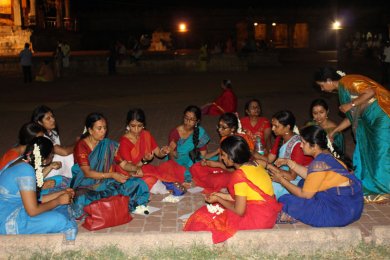 Teacher showing how to string flowers The contrast between Brihadeeswara temple and the temple at Gangaikondacholapuram was notable. Brihadeeswara was larger, and as has been noted in several texts, it seemed more masculine and imposing than Gangaikondacholapuram, which is more decorative and elegant. The temple was also much more populated than its descendant, and the contrast between the quiet peace of Gangaikondacholapuram and the festive hubbub of Tanjavur was striking. The sun was setting quickly, and already we could hear the beginning strains of music playing in the air. It turned out that we had arrived at the temple on the day that a Carnatic concert was playing, with nadhaswaram, tavil, veena, saxophone, mridangam and other accompaniments. As a result, we were not permitted to dance in the temple, so that we would not distract from the concert. After prayers, we sat down to watch the concert, and Teacher taught us to string flowers together, in the traditional style. It seemed to require a great deal of dexterity, looping one thread around another and twisting them through each other. Unfortunately, I couldn't seem to quite get the hang of it, and seemed to end up ruining the flowers rather than creating a garland. My sister fared little better - she abandoned the traditional method and simply started tying knots! 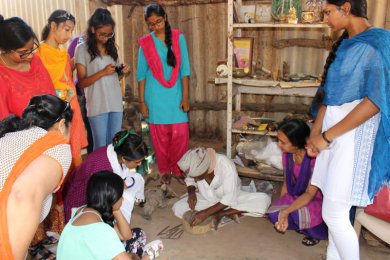 Master metal sculptor demonstrates
We did not return to the temple the next day. Instead, Teacher took us to experience some of the arts unique to Tanjavur. We drove to a tiny village where the walls were painted with beautiful murals and chickens ran around behind the trees. This village is special in that it makes by hand the unique sculpture and painting that Tanjavur is famous for, in comparison to factories which mass-produce and sell them. A master sculptor showed us his craft, as he mixed together 5 different metals for the alloy, and then poured it into a (also hand-made) mould of resin, which was then set into a kiln built up and buried in the earth. He told us about the procedure, and allowed us to handle one of his sculptures which were in the process of being made. He then introduced us to his father, a tiny old man who sat near him, lovingly chiselling details onto a sculpture of a devi, such as the contours and expression on her serene face and the folds and pleats of her sari. The old man's work was so deft and elegant that it seemed almost impossible that the finished creation had been made by human hands. Afterwards we were invited to view the village shop, where they sold their sculptures. This shop was full of bronze sculptures from images of Krishna - both as a baby and as a youth - to fearsome Durgas, along with ghoulish protections from the evil eye, decorative lamps, and tirtha-holders. That same village also creates the famous Tanjavur paintings, which have gold and precious jewels (later they began using gold leaf and semi-precious stones for economic reasons) embedded in them as part of the decoration. The sculptor told us that the village split the work relatively equally, with the women working on the paintings and the men on the sculptures. We were all awed by the quality of the paintings - we saw one Saraswati painting with a face so serene and beautiful that my mother couldn't help but buy it! I was enchanted by a delicate miniature featuring a woman (probably Damayanti) gazing wistfully at a swan at night - it was not a typical Tanjavur painting, with gold and jewel decorations, but the romance and elegance of the painting was such that it was complete without any of them. After the village, we went to a veena workshop in the town nearby, where we learnt about the procedure of making a veena and the work that was involved in it. The lady who owned the workshop told us about the two types of veenas, and the significance of the wood used for it and the way each step of making the veena contributed to the final product. We were also shown into the front room of the shop, where we were invited to try our hand at plucking at the strings of the beautiful instrument. In the afternoon we went to Thyagaraja temple at Thiruvarur, which was of especial interest to us as dance students because it is said to be the seat of Bharatanatyam. There a priest showed us around the temple, telling us about the intricate history which had unfolded there. We saw the thousand pillar mandapam, where the Bharatanatyam dancers of old would have performed, and the huge, towering chariot which a Chola king was said to have ordered his son to be run over by (the son had run over the child of a cow, who had then demanded compensation). We were also taken to see a chariot which was being constructed for the Chariot Festival next year - the current chariot is already the largest in India, with its successor being built to surpass it. The chariot, even though it was unfinished (and had been in the works for several years) was breathtaking- made of deep, dark wood, it towered above us, adorned with several different and intricate images of devas, devis, gandharvas, gandharvis, and many other holy and celestial figures. In the evening we went to the immense water tank of the temple, where Teacher taught us to create kolams. We had seen several kolams before, especially in Chidambaram during the evening procession, and so this impromptu tutorial was very much enjoyed; it was almost meditative and soothing in its execution. The next morning, we awoke up at 5am to dance in Brihadeeswara temple - we had learnt our lesson from Chidambaram, and so we all hurried to dress to arrive on time! We danced in the early morning, when it was still cool and slightly dewy, and were then led by the same guide as before to see the inscriptions on the temple fašade. These inscriptions were unique to the temple in that they proclaimed the exact amount given by each individual as donation to the founding of the temple - highly unusual, when a king would typically assume acknowledgement for that donation himself. After breakfast, we made our way once more to the temple to receive an official tour from the same guide. First we went to the temple museum. This museum had extensive information - great boards of both Tamil and English explaining the history of the temple and the legends and lore associated with it. There was also a considerable amount of art - mostly photographs of paintings that lined the inner corridors of the temple: these had been cordoned off from the public due to damage which had been done to the paintings over time. We also saw a display of stone karanas. After lunch, Teacher told us that she would be leading a second workshop for us. Initially, we repeated what we had learnt at Chidambaram, recounting what we had done over the past few days through the medium of Bharatanatyam. We learned about the importance of nrittam, nrityam and natyam, and about the importance of combining the two when performing dance. Then we talked about the history of devadasis, and their significance in shaping the way Bharatanatyam is performed today. To our delight, Teacher then taught us a new dance, as she had promised. It was dedicated to Lord Shiva and the beauty of his dance. This workshop marked the end of the dance trip, which was so packed with activity and excitement that it felt to me as if a whole month had passed instead of a week! I had learnt so much - not just about the history of Bharatanatyam but about Indian culture and heritage that is so unique and enthralling. Tara Panicker is a student of Usha Raghavan, Director, Kalasagara UK. She is a second year student studying Classics at the University of St. Andrews. Post your comments Please provide your name and email id when you use the Anonymous profile in the blog to post a comment. All appropriate comments posted with name & email id in the blog will also be featured in the site. |